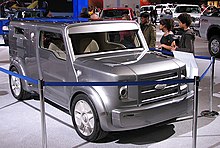Ford SYNus
The Ford SYNus is a concept car from Ford developed by Spanish designers Jose Paris (exterior design) and Joe Baker (interior design). The SYNus debuted at the North American International Auto Show in 2005.
The unusual name, which is pronounced as "sin-iu-es", comes from "synthesis" (synthesis of the hard exterior and the soft interior) and "US", which stands for "Urban Sanctuary". His name is a homophone of "winding", which means "curved" or "graceful".
design
The design mimics an armadillo as it has a sturdy exterior and a soft interior. "Armadillo" (English for "armadillo") was the production name of the SYNus, but was discarded when it was discovered that there was a concept car from Fiat with that name. Other production names were Ford "Knox" and "Gorilla".
The SYNus shares its powertrain design with the Ford Mondeo . The engine is a diesel powered, 16 valve, turbocharged , 2.0L DOHC 4-cylinder Duratorq TDCi diesel engine that develops 134 hp (100 kW). The SYNus has a five-speed manual transmission . Its wheels have a diameter of 457 mm. It has an IEEE 802.11g -compatible WLAN hub. The SYNUS is designed to maximize the security and passes its aesthetics of modern bank vaults from. The windows and frame of the car are bulletproof. It has no rear window and instead shows a video feed on a large LCD monitor installed in the back of the interior of the car. Even in “lockdown mode”, the steel shutters close around the front windshield, the windows and the exterior lights.
As already mentioned, the car is also an “urban sanctuary”. In “lockdown mode”, the car seats can be configured to face backwards, watch films or relax in otherwise hectic city life. With this in mind, the car can be used to lock out the outside world.
Individual evidence
- ↑ How the Ford SYNUS Works. February 9, 2005, accessed March 18, 2020 .
- ↑ Form follows function. Retrieved March 18, 2020 .
